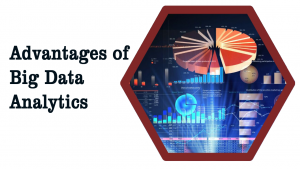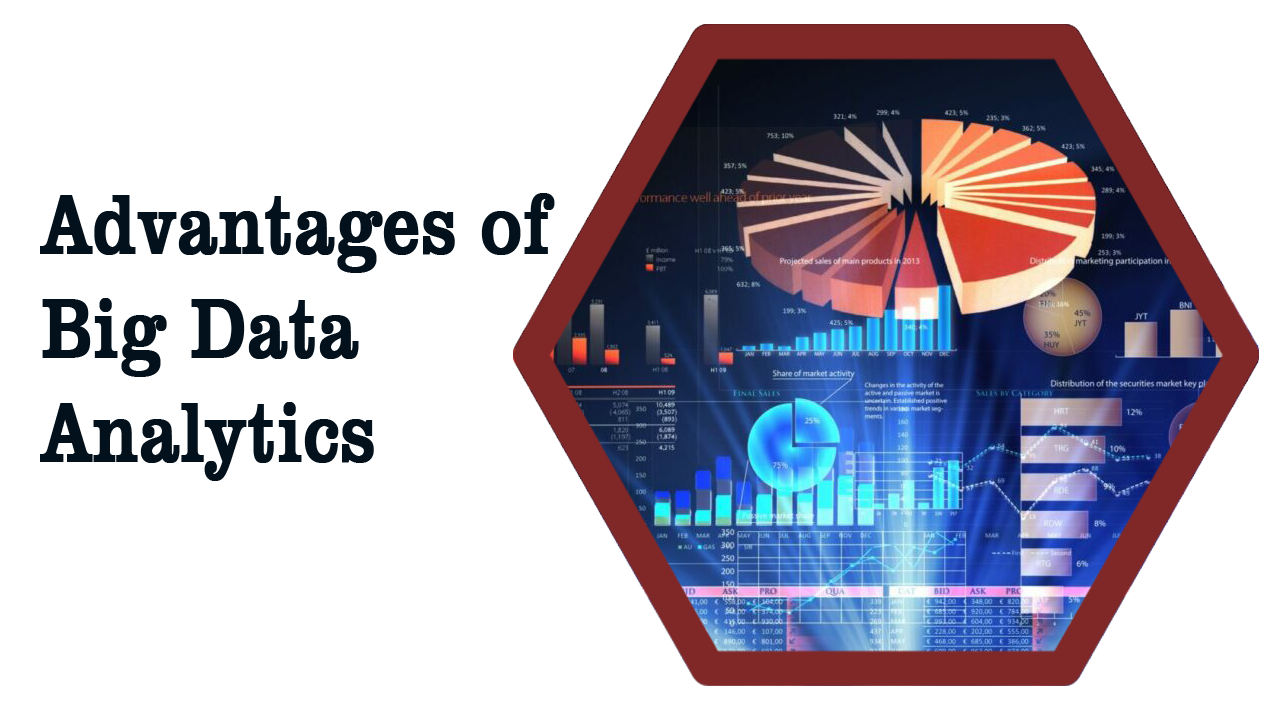Introduction Advantages of Big Data Analytics
Big Data Analytics has become an essential tool for businesses and organizations looking to make data-driven decisions and gain valuable insights from their data. In this article, we will explore some of the advantages of Big Data Analytics and how they can benefit organizations. 
Advantages of Big Data Analytics
1. Improved Decision-Making One of the most significant advantages of Big Data Analytics is that it enables organizations to make more informed decisions. Big Data Analytics provides organizations with insights that were previously hidden in the data, allowing them to make data-driven decisions that optimize their operations.
2. Cost Savings Big Data Analytics can help organizations identify cost savings opportunities by optimizing their operations and reducing waste. This can result in significant cost savings for organizations.
3. Improved Customer Experience Big Data Analytics can help organizations better understand their customers and provide them with a better experience. This can lead to increased customer loyalty and revenue.
4. Competitive Advantage Big Data Analytics can provide organizations with a competitive advantage by enabling them to make more informed decisions and optimize their operations. This can help organizations outperform their competitors and achieve greater success.
5. Predictive Analytics Big Data Analytics enables organizations to use predictive analytics to forecast future trends and identify potential opportunities and risks. This helps organizations make proactive decisions that can lead to significant business growth.
6. Real-Time Analytics Big Data Analytics enables organizations to analyze data in real-time, providing them with up-to-date insights that can be used to make timely decisions. 7. Improved Marketing Big Data Analytics can help organizations optimize their marketing efforts by providing them with insights into customer behavior and preferences.
This can help organizations target their marketing efforts more effectively, resulting in increased revenue and customer loyalty. 8. Personalization Big Data Analytics enables organizations to personalize their products and services based on customer behavior and preferences. This can lead to increased customer satisfaction and loyalty.
Benefits of Big Data Analytics in Different Industries
1. Healthcare Big Data Analytics can help healthcare organizations optimize patient care by analyzing patient data and identifying potential health risks. This can lead to better patient outcomes and reduced healthcare costs.
2. Retail Big Data Analytics can help retailers optimize their operations by analyzing customer data and identifying trends in customer behavior. This can help retailers improve their inventory management and optimize their pricing strategies.
3. Finance Big Data Analytics can help financial institutions identify potential fraud and money laundering activities. This can help institutions reduce their financial losses and comply with regulatory requirements.
4. Manufacturing Big Data Analytics can help manufacturers optimize their operations by analyzing sensor data and identifying potential equipment failures before they occur. This can help manufacturers avoid costly downtime and maintenance costs.
Challenges of Big Data Analytics
While Big Data Analytics has many advantages, it also comes with its own set of challenges. Some of the challenges include:
1. Data Quality Big Data Analytics projects rely on high-quality data. However, the quality of data can be compromised due to various factors, such as data entry errors, inconsistent data formats, and data duplication. This can affect the accuracy of the insights generated by Big Data Analytics projects.
2. Scalability Big Data Analytics projects require significant computing resources to process large amounts of data. Organizations need to ensure that their infrastructure can handle the workload generated by Big Data Analytics projects. 3. Skilled Professionals Big Data Analytics projects require skilled professionals with expertise in data science, machine learning, and programming. However, there is a shortage of skilled professionals in this field, making it difficult for organizations to find and hire the right talent.
Conclusion Advantages of Big Data Analytics
Big Data Analytics has become an essential tool for organizations looking to make data-driven decisions and gain valuable insights from their data. It provides organizations with many advantages, including improved decision-making, cost savings
Advantages of Big Data Analytics
In today’s digital age, big data analytics has emerged as a game-changer for organizations across all industries. The ability to collect, analyze, and interpret vast amounts of data has provided unprecedented opportunities for businesses to gain insights, drive decision-making, and foster innovation. This article explores the key advantages of big data analytics, demonstrating how it can significantly enhance operational effectiveness, strategic planning, and overall business performance.
1. Enhanced Decision-Making
Overview: One of the primary benefits of big data analytics is its capacity to improve decision-making processes by providing comprehensive, data-driven insights.
Key Advantages:
- Data-Driven Insights: Decisions are based on thorough analysis rather than intuition, leading to more accurate and reliable outcomes.
- Real-Time Analysis: Enables organizations to make timely decisions by analyzing data as it is generated, allowing for swift responses to emerging trends and issues.
Example: Financial services firms use big data analytics to assess market trends and customer behavior, enabling them to make more informed investment decisions and risk assessments.
2. Improved Customer Experience
Overview: Big data analytics allows organizations to better understand their customers, leading to enhanced customer experiences and satisfaction.
Key Advantages:
- Personalization: Tailors products, services, and marketing efforts to individual customer preferences based on detailed data analysis.
- Customer Insights: Provides a deeper understanding of customer behaviors, needs, and feedback, allowing for improved service delivery and engagement.
Example: E-commerce companies like Amazon use big data analytics to recommend products based on customers’ browsing and purchase histories, enhancing the shopping experience.
3. Increased Operational Efficiency
Overview: By analyzing operational data, big data analytics helps organizations streamline their processes and improve overall efficiency.
Key Advantages:
- Process Optimization: Identifies inefficiencies and bottlenecks in workflows, leading to more effective and streamlined operations.
- Resource Management: Optimizes the allocation of resources such as inventory, labor, and equipment to reduce waste and lower costs.
Example: Manufacturing companies use big data analytics to monitor machinery performance and predict maintenance needs, reducing downtime and increasing production efficiency.
4. Revenue Growth and Profitability
Overview: Big data analytics drives revenue growth and enhances profitability by uncovering new opportunities and optimizing pricing strategies.
Key Advantages:
- Revenue Opportunities: Identifies new market segments, customer needs, and product opportunities that can drive additional revenue.
- Pricing Optimization: Analyzes market data to set competitive pricing strategies that maximize profitability and market share.
Example: Airlines use big data analytics to optimize ticket pricing based on demand forecasts, competitive pricing, and customer behavior, leading to increased revenue.
5. Innovation and Competitive Advantage
Overview: Big data analytics fosters innovation by providing insights that drive the development of new products, services, and business models.
Key Advantages:
- Trend Identification: Detects emerging trends and market demands, helping organizations innovate and stay ahead of competitors.
- Strategic Planning: Provides data-driven insights that support strategic planning and the development of new business strategies.
Example: Technology firms leverage big data to analyze user feedback and market trends, leading to the creation of innovative products and features that meet evolving customer needs.
6. Enhanced Risk Management
Overview: Big data analytics improves risk management by identifying potential risks and vulnerabilities through comprehensive data analysis.
Key Advantages:
- Risk Prediction: Uses historical and real-time data to predict potential risks and take preventive measures.
- Fraud Detection: Analyzes transaction patterns and behaviors to detect and prevent fraudulent activities.
Example: Insurance companies use big data analytics to assess risk factors and predict claim probabilities, improving their risk management strategies and underwriting processes.
7. Better Financial Planning and Forecasting
Overview: Big data analytics supports more accurate financial planning and forecasting by providing detailed insights into financial performance and trends.
Key Advantages:
- Accurate Forecasting: Utilizes predictive models to forecast financial trends, helping organizations plan budgets and investments more effectively.
- Financial Insights: Offers detailed insights into revenue, expenses, and profitability, enabling better financial decision-making.
Example: Retail chains use big data analytics to forecast sales and manage inventory levels, leading to improved financial planning and reduced stockouts.
8. Enhanced Supply Chain Management
Overview: Big data analytics optimizes supply chain management by providing insights that improve logistics, inventory management, and supplier relationships.
Key Advantages:
- Logistics Optimization: Analyzes data to optimize transportation routes and reduce delivery times, improving overall supply chain efficiency.
- Inventory Management: Forecasts demand and manages inventory levels to prevent overstock and stockouts.
Example: Global retailers use big data to monitor and optimize their supply chains, ensuring timely deliveries and reducing operational costs.
9. Improved Marketing Strategies
Overview: Big data analytics enhances marketing strategies by providing insights into customer behaviors, campaign performance, and market trends.
Key Advantages:
- Targeted Campaigns: Enables more precise targeting of marketing efforts, resulting in higher engagement and conversion rates.
- Campaign Optimization: Analyzes marketing campaign data to refine strategies, improve content, and adjust tactics for better results.
Example: Social media platforms use big data analytics to track engagement metrics and user behavior, allowing marketers to optimize their social media campaigns and content strategies.
10. Contribution to Strategic Goals
Overview: Big data analytics aligns with and supports the achievement of strategic business goals by providing actionable insights and data-driven recommendations.
Key Advantages:
- Goal Alignment: Ensures that business strategies and initiatives are based on accurate data, enhancing the likelihood of achieving strategic objectives.
- Performance Measurement: Tracks and measures progress towards strategic goals, allowing for adjustments and improvements as needed.
Example: Enterprises use big data analytics to measure and track key performance indicators (KPIs) related to their strategic goals, ensuring alignment and progress towards achieving business objectives.
Conclusion
The advantages of big data analytics are vast and impactful, driving significant improvements across various dimensions of business operations. By enhancing decision-making, improving customer experiences, increasing operational efficiency, and fostering innovation,
big data analytics empowers organizations to navigate the complexities of the modern data landscape and achieve strategic success. Embracing big data analytics not only provides valuable insights but also positions organizations to capitalize on new opportunities and maintain a competitive edge in an increasingly data-driven world.
